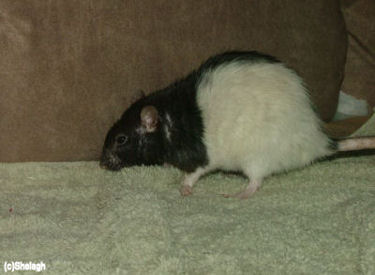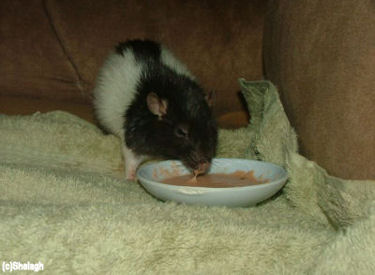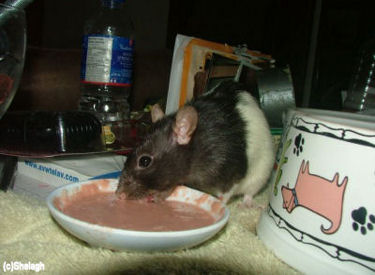Figure 2: Pituitary tumor in 15-month-old female rat (Ariel).
Case history, photos, and video
History
The following is the case history of Ariel a 15 month old 330 gram female rescue rat.
Clinical Signs
- Loss of 30 grams in 2 weeks.
- No constant porphyrin, just a tiny bit in her eye once or twice.
- Lethargy.
- Very limp and light feeling (more than her weight loss should be).
- Random head movements like she was confused.
- A small amount of head bumping when stroked over her head, but not a lot.
- A lot of swallowing, a little bruxing.
- She isn’t able to grasp things with her left paw…she would club it and push it against the food item and grasps with her right paw, but then it slips and she has to work the food back into an eating position.
- She is doing a lot of morning stretch and yawns which we think indicates pain…not an owwie stretch.
- She also had some blood in her urine (hematuria) and was started on baytril right away, the bloody urine (hematuria) went away for awhile but the other clinical signs listed above did not improve.
The above signs were noticed on weekend, and a vet appointment was made right away for Monday morning.
Diagnosis
Discussed with vet and it was decided all these behaviors and symptoms were neurological, and a pituitary tumor was most likely the cause.
(*Note: necropsy not performed for verification)
Initial Treatment
At the vets while lying on the towel she was flat on her belly with some of her paws knuckled over or her limbs crooked– they had to be straightened.
She was palpated and her uterus was fine, no mass but her bladder was tender and there was a little thickening.
Ariel was put on .06 cc of Baytril when bloody urine showed up on weekend, and .3 cc of chloramphenicol was added 2 days later, as well as a 3 day diagnostic dose of .04 cc of Metacam daily to see if there was any pain.
Follow-up Treatment
After 3 days the rat had worsened slightly so the Metacam was discontinued and .04 cc of injectable dexamethasone was given subcutaneously every 2nd day.
Within 8 hours she was a different rat, mobile and running, eating properly grasping with her forepaws.
After 2 weeks of the subcutaneous dexamethasone injections, Ariel started to fight her owner when she was trying to inject her. Her owner who was on her own, after many futile attempts, decided to stop that treatment and let her peacefully go. Within hours she had worsened and was suffering badly. The vet clinic was closed so the owner decided to give the dexamethasone orally in baby cereal as a last effort. The vet was informed of the change the next day and soon after her dose Ariel improved once again.
The following 2 weeks were mostly good days with a few regressions thrown in.
The hematuria (bloody urine) was never resolved even with medication.
Outcome
After 5 weeks Ariel finally worsened and didn’t improve, she passed quietly at home at night.
Video
Video 1: Day of vet visit.
Rat shows confusion and weakness, difficulty figuring out where baby cereal is.
Video 2: Day 3 following vet visit.
After initial dexamethasone injection, the rat appears alert, active, much more coordinated and able to use paws.
Video 3: After the dexamethasone injections were stopped, regression can be observed.
Photos
 Photo 1: Shows clubbed left front paw. |
 Photo 2: Day of vet visit. The rat shows a loss of coordination when eating. |
 Photo 3: Shows improved coordination while being treated with dexamethasone orally. |
Case history and photos courtesy of Shelagh Hall and “Ariel.”


